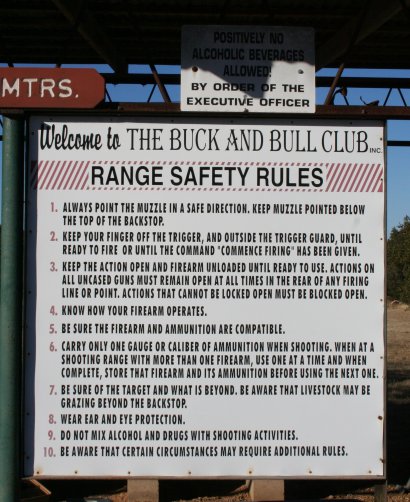
Range Rules
Safety: First, Last, and Always
- Always point the muzzle in a safe direction. Keep the muzzle of a loaded weapon pointed below the top of the backstop to avoid sending a bullet off the range.
- Keep your finger off the trigger, and outside the trigger guard, until ready to fire or until the command "Commence firing" has been given.
- Keep the action open and the firearm unloaded until ready to use. Actions on all uncased guns in the rear of any firing line or point must remain open at all times. Actions that cannot be locked open must be blocked open.
- Know how your firearm operates. Be sure the firearm and ammunition are compatible.
- FULLY AUTOMATIC WEAPONS are NOT allowed. Do not draw from a holster. Start from a ready position instead.
- Shoot only at paper targets, and only at targets which are directly in front of your firing point. Do not shoot across ranges.
- Be sure of the target and what is beyond. Be aware that livestock may be grazing beyond the backstop. If livestock appear on the range, cease firing until they are clear of the ranges.
- Wear ear and eye protection.
- Do not mix alcohol and drugs with shooting activities.
- Be aware that certain circumstances may require additional rules.
- The 7 yd, 25m, 50m, 100m and the silhouette ranges operate as one unit. A cease fire must be called on all to move downrange. The 200 yd range operates independently.
- The first shooter onto the firing line is the Range Safety Officer (RSO) and controls the range operations. When the RSO is no longer a shooter or leaves the firing line, another RSO must be appointed or volunteered to control the range.
- When a cease fire is called, all weapons must be unloaded. Be sure by voice confirmation that all shooters know that a cease fire has been called. Senior ears and shooting muffs make it difficult for shooters to hear range commands. Only then is it safe to go downrange.
- During a cease fire, DO NOT HANDLE a weapon on the firing line. People who are downrange become nervous and ill-tempered.
- Complete safety rules are found in the Members Book.
Sign in immediately upon arrival. List any guests in the ledger book. Guests must also complete a Waiver form, and the member must sign the form too. The member is responsible for the behavior of the guests.
Positively no alcoholic beverages are allowed on the Buck and Bull Club range property.
There is non-potable running water for the restrooms. Bring water to drink.
Use of a spotting scope on the rifle ranges is recommended for viewing targets and shot groups from the firing line so as not to unduly call for cease fires.
Use a stapler to post paper targets onto the backerboards, shooting 1/2" staples into the backerboard.
Shooters and particularly younger shooters enjoy the reactive targets (bang clang on steel) on the silhouette ranges, and those targets can be knocked down quickly. Avoid calling for frequent cease fires to reset targets as that would impose on shooters on the other ranges whose shooting is more deliberate.
Target backerboards and the header and footer boards on the target lines are expendable and must be replaced periodically. Spare backerboards and hammer and roofing nails are stored in the supply shed, as are replacemet 2"x4"header and footer boards. Please replace what is shot out. There is no range maintenance officer to do that.
There is no waste serivce at the range. Take your trash with you when you leave the range.
Pick up your empty brass before you leave, except for 22 rimfire brass. If you don't want your brass, leave it in a pile on a table at the firing line and someone who reloads will appreciate it.

